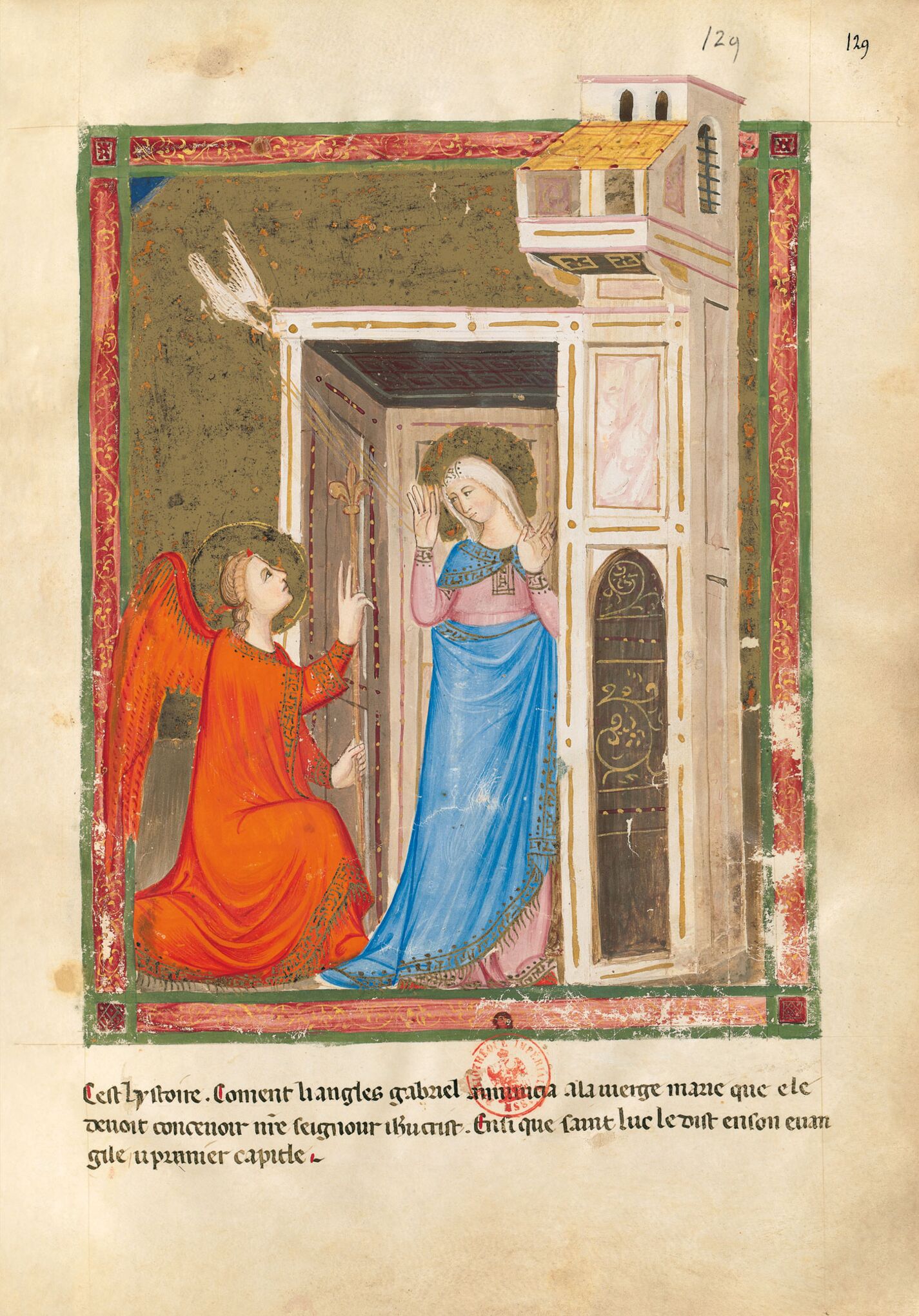“This is the story: How the angel Gabriel announces to the Virgin Mary that she will conceive Our Lord Jesus Christ. Thus says Saint Luke in his gospel in the first chapter.”
A famous theme if ever there was one, depicted on countless occasions in Trecento art, the Annunciation to Mary of her forthcoming conception of Christ is codified by the painting technique employed in several influential models. The iconography used by the great Sienese masters (The Virgin seated with a book) was not adopted by artist A working on the New Testament cycle in Naples. However, Our Lady standing in her house and surprised by the angel Gabriel kneeling at her feet, is reminiscent of the overall composition of the Annunciation panel painted in c. 1343-1350 by Taddeo Gaddi (Fiesole, Bandini Museum).
The structure of the house with a turret and balcony, shown in a three-quarter view, permits the indoors and outdoors of a constructed space to be viewed from different angles. The action takes place in a quadrangular room open at the front and devoid of any pictorial devices, an intellectualised place where the eruption of the angel is the metonymic equivalent of the “penetration of the inside by the outside”, and the Holy Ghost is depicted in the shape of a dove. Mary steps back slightly but she looks downwards towards the heavenly messenger and shows the palms of her open hands: an indication of her listening and acceptance. “Behold the handmaid of the Lord, be it done unto me according to thy word”, was her answer to the heavenly messenger telling her that she is to conceive, have a son and call him Jesus whilst the Holy Ghost shines his golden rays upon her. The closed door on the right is perhaps a reference to the virginal motherhood of Mary according to the Fathers of the Church. The angel Gabriel holds a long sceptre ending in a fleur-de-lys, a flower that symbolises choice, the choice of the beloved according to biblical tradition, and which also became Our Lady’s emblem in the Christian tradition. The contrast of his flame-coloured robe, the same colour as the small flame burning on his forehead, brightens up the delicate, pale palette of the painting as a whole and vividly emphasises the intrusion of God’s world into human reality. From a theological viewpoint, the mystery of the Incarnation is in fact based on the dogma of the Word made flesh that underpins the Christian faith. The Annunciation marks the transition from the Old Law to the era of grace, redemption and salvation made possible by Christ’s sacrifice.
Yves Christe
University of Geneva
Marianne Besseyre
Illuminated Manuscripts Research Center, Bibliothèque nationale de France
Fragment of the Bible moralisée of Naples commentary volume

“This is the story: How the angel Gabriel announces to the Virgin Mary that she will conceive Our Lord Jesus Christ. Thus says Saint Luke in his gospel in the first chapter.”
A famous theme if ever there was one, depicted on countless occasions in Trecento art, the Annunciation to Mary of her forthcoming conception of Christ is codified by the painting technique employed in several influential models. The iconography used by the great Sienese masters (The Virgin seated with a book) was not adopted by artist A working on the New Testament cycle in Naples. However, Our Lady standing in her house and surprised by the angel Gabriel kneeling at her feet, is reminiscent of the overall composition of the Annunciation panel painted in c. 1343-1350 by Taddeo Gaddi (Fiesole, Bandini Museum).
The structure of the house with a turret and balcony, shown in a three-quarter view, permits the indoors and outdoors of a constructed space to be viewed from different angles. The action takes place in a quadrangular room open at the front and devoid of any pictorial devices, an intellectualised place where the eruption of the angel is the metonymic equivalent of the “penetration of the inside by the outside”, and the Holy Ghost is depicted in the shape of a dove. Mary steps back slightly but she looks downwards towards the heavenly messenger and shows the palms of her open hands: an indication of her listening and acceptance. “Behold the handmaid of the Lord, be it done unto me according to thy word”, was her answer to the heavenly messenger telling her that she is to conceive, have a son and call him Jesus whilst the Holy Ghost shines his golden rays upon her. The closed door on the right is perhaps a reference to the virginal motherhood of Mary according to the Fathers of the Church. The angel Gabriel holds a long sceptre ending in a fleur-de-lys, a flower that symbolises choice, the choice of the beloved according to biblical tradition, and which also became Our Lady’s emblem in the Christian tradition. The contrast of his flame-coloured robe, the same colour as the small flame burning on his forehead, brightens up the delicate, pale palette of the painting as a whole and vividly emphasises the intrusion of God’s world into human reality. From a theological viewpoint, the mystery of the Incarnation is in fact based on the dogma of the Word made flesh that underpins the Christian faith. The Annunciation marks the transition from the Old Law to the era of grace, redemption and salvation made possible by Christ’s sacrifice.
Yves Christe
University of Geneva
Marianne Besseyre
Illuminated Manuscripts Research Center, Bibliothèque nationale de France
Fragment of the Bible moralisée of Naples commentary volume